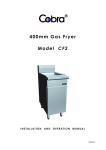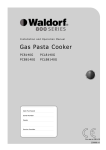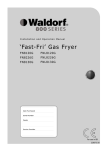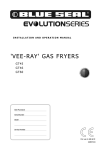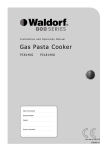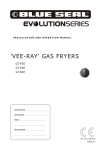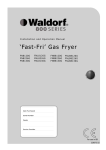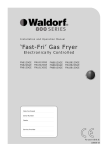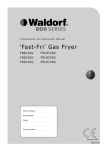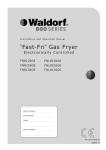Download Cobra cf4 Specifications
Transcript
400mm Gas Fryer Model CF4 INSTALLATION AND OPERATION MANUAL For use in GB & IE 230114-9 MANUFACTURED BY Moffat Limited Christchurch New Zealand INTERNATIONAL CONTACTS AUSTRALIA Moffat Pty Limited E.Mail: Main Office: Service: Spares: Customer Service: [email protected] (tel): +61 (03) 9518 3888 (fax): +61 (03 9518 3833 (tel): 1800 622 216 (tel): 1800 337 963 (tel): 1800 335 315 (fax): 1800 350 281 CANADA Serve Canada Web: E.Mail: Sales: Service: www.servecanada.com [email protected] (tel): 800 551 8795 (Toll Free) (tel): 800 263 1455 (Toll Free) NEW ZEALAND Moffat Limited Web: E.Mail: Main Office: www.moffat.co.nz [email protected] (tel): 0800 663328 UNITED KINGDOM Blue Seal Web: E.Mail: Sales: Spares: Service: www.blue-seal.co.uk [email protected] (tel): +44 121 327 5575 (fax): +44 121 327 9711 (tel): +44 121 322 6640 (fax): +44 121 327 9201 (tel): +44 121 322 6644 (fax): +44 121 327 6257 UNITED STATES Moffat Web: Sales: Service: www.moffat.com (tel): 800 551 8795 (Toll Free) (tel): +1 336 661 1556 (fax): +1 336 661 9546 (tel): 800 858 4477 (Toll Free) (tel): +1 366 661 1556 (fax): +1 336 661 1660 REST OF WORLD Moffat Limited Web: E.Mail: www.moffat.co.nz [email protected] The reproduction or copying of any part of this manual by any means whatsoever is strictly forbidden unless authorized previously in writing by the manufacturer. In line with policy to continually develop and improve its products, Moffat Ltd. reserves the right to change the specifications and design without prior notice. © Copyright Moffat Ltd. September 2011. Contents CF4 GAS FRYER (Single Tank - 21 Ltr) Part 1 Introduction ..................................................................................... 2 Part 2 Specifications .................................................................................. 3 Part 3 Installation ........................................................................................ 4 Part 4 Operation ......................................................................................... 7 Part 5 Cleaning and Maintenance ......................................................... 11 Part 6 Wiring Schematic........................................................................... 13 Part 7 Gas Conversion ............................................................................. 14 Part 8 Replacement Parts List .................................................................. 17 1 Part 1 Introduction We are confident that you will be delighted with your Cobra Gas Fryers, and it will become a most valued appliance in your commercial kitchen. To ensure you receive the utmost benefit from your new Cobra Appliance, there are two important things you can do. Firstly: Please read this instruction book carefully and follow the directions given. The time taken will be well spent. Secondly: If you are unsure of any aspect of the installation, instructions or performance of your appliance, contact your Cobra Fryer dealer promptly. In many cases a phone call could answer your question. CE Only: These instructions are only valid if the country code appears on the appliance. If the code does not appear on the appliance, refer to the supplier of this appliance to obtain the technical instructions for adapting the appliance to the conditions for use in that country. WARNING: IMPROPER INSTALLATION, ADJUSTMENT, ALTERATION, SERVICE OR MAINTENANCE CAN CAUSE PROPERTY DAMAGE, INJURY OR DEATH. READ THE INSTALLATION, OPERATING AND MAINTENANCE INSTRUCTIONS THOROUGHLY BEFORE INSTALLING OR SERVICING THIS APPLIANCE. WARNING: INSTRUCTIONS TO BE FOLLOWED IN THE EVENT THE USER SMELLS GAS ARE TO BE POSTED IN A PROMINENT LOCATION. THIS INFORMATION SHALL BE OBTAINED BY CONSULTING THE LOCAL GAS SUPPLIER. WARNING: GREAT CARE MUST BE TAKEN BY THE OPERATOR TO USE THE EQUIPMENT SAFELY TO GUARD IT AGAINST RISK OF FIRE. THE APPLIANCE MUST NOT BE LEFT ON UNATTENDED. IT IS RECOMMENDED THAT A REGULAR INSPECTION IS MADE BY A COMPETENT SERVICEMAN TO ENSURE CORRECT AND SAFE OPERATION OF YOUR APPLIANCE IS MAINTAINED. DO NOT STORE OR USE GASOLINE OR OTHER FLAMMABLE VAPOURS OR LIQUIDS IN THE VICINITY OF THIS OR ANY OTHER APPLIANCE. DO NOT SPRAY AEROSOLS IN THE VICINITY OF THIS APPLIANCE WHILE IT IS IN OPERATION. C AUTIO N : This appliance is; For professional use and is to be used by qualified persons only. Only qualified service conversion operations. Components having adjustments protected (e.g. paint sealed) by the manufacturer should not be adjusted by the user / operator. DO NOT operate the appliance without the legs supplied fitted. persons are to carry out installation, servicing and gas Part 2 Specifications Model Covered in this Specification - CF4 GAS FRYER (Single Tank - 21 Ltr). General Gas Connection A commercial gas fired fryer having a fast fry infra red burner system which an intense even heat through the tank. It is available in single model type. This model fitted with dual main burners and pilot burners, fitted with a single gas controller which controls both pilot and main burners. This Fryer is fitted with an Over Temperature Safety Cut Out system with Full Flame Failure Safety Controls. Thermostatically regulated gas controls with snap action thermostat sensitive to changes in oil temperature which improves both recovery and output. An open tank design to make cleaning a simple and easy task. Gas supply connection point is located 200 mm from the right hand side, 31 mm from the rear and 124 mm from the floor and is entered from beneath the appliance. - Flexible Hose Connection If a Gas Hose assembly is used to connect this appliance, the hose and all fittings must have a minimum ¾” (Natural Gas) or ½” (LPG) inside bore diameter to ensure gas flow rate capacity required by this appliance is achieved. This must be verified by the operating pressure testing at the maximum gas supply demand condition. The Gas Hose assembly should also be classified for use in the commercial kitchen conditions, the appliance will be used in. Gas Supply Requirements - Non - UK Only: Natural Gas Input Rating (N.H.G.C.) 85 MJ/hr (80,560 BTU/hr) (80,560 BTU/hr) Supply Pressure 1.13 - 3.40 kPa 2.75 - 4.50 kPa 0.8 kPa (*) 2.5 kPa (*) Burner Operating Pressure Gas Connection CF4 GAS FRYER (Single Tank - 21 Ltr) LP Gas (Propane) 85 MJ/hr ¾” BSP Male - UK Only: Heat Input (nett) Gas Rate Supply Pressure Burner Operating Pressure Gas Connection Natural Gas (G20) Propane (G31) 22.0 kW 22.0 kW 2.33 m3/hr 1.71 kg/hr 1.13 - 3.40 kPa 2.75 - 4.50 kPa 8.6 mbar (*) 26.4 mbar (*) ¾” BSP Male NOTE: (*) The burner operating pressure is to be measured at the Outlet Pressure test point on the gas control valve with both burners operating. The operating pressure is ex-factory set, through the appliance regulator and not to be adjusted, apart from when carrying out gas conversion, if required. Refer to the ‘Gas Conversion Instructions’ supplied with the gas conversion kit, available on request. 3 Part 3 Installation Installation Requirements Location NOTE: It is most important that this appliance is installed correctly and that operation is correct before use. Installation shall comply with local, gas, health and safety requirements. 1. 2. This appliance must be installed in a suitably ventilated room to prevent dangerous build up of combustion products. Installation must allow for a sufficient flow of fresh air for the combustion air supply. This appliance shall be installed with sufficient ventilation to prevent the occurrence of unacceptable concentrations of health harmful substances in the room, the appliance is installed in. Combustion Air Requirements Natural Gas LPG / Propane Cobra gas fryers are designed to provide years of satisfactory service and correct installation is essential to achieve the best performance, efficiency and trouble-free operation. This appliance must be installed in accordance with National installation codes and in addition, in accordance with relevant National / Local codes covering gas and fire safety. Australia: AS 5601- Gas Installations. New Zealand: United Kingdom: NZS 5261- Gas Installation. Gas Safety (Installation and Use) Regulations 1998. IS 820 - Non Domestic Gas Installations. Ireland: 3. Position the appliance in its approximate working position. 4. All air for burner combustion is supplied from underneath the appliance. The legs must always be fitted and no obstructions placed on the underside or around the base of the appliance, as obstructions will cause incorrect operation and / or failure of the appliance. 5. Components having adjustments protected (e.g. paint sealed) by manufacturer are only allowed to be adjusted by an qualified service agent. They are not to be adjusted by the installation person. NOTE: Do not obstruct or block the appliances flue. Never directly connect a ventilation system to the appliance flue outlet. Installations must be carried out by qualified service persons only. Failure to install equipment to the relevant codes and manufacturer’s specifications shown in this section will void the warranty. Clearances Components having adjustments protected (e.g. paint sealed) by manufacturer, are only allowed to be adjusted by an qualified service agent. They are not to be adjusted by the installation person. NOTE: Only non-combustible materials can be used in close proximity to this appliance. In order to facilitate easy operation, drainage and servicing of the appliance, a minimum of 600 mm clearance should be maintained at the front of the appliance. Unpacking Remove all packaging and transit protection from the appliance including all protective plastic coating from the door outer panel and exterior stainless steel panels. Any gas burning appliance requires adequate clearance and ventilation for optimum and troublefree operation. The following minimum installation clearances are to be adhered to:- Check equipment and parts for damage. Report any damage immediately to the carrier and distributor. Report any deficiencies to the distributor who supplied the appliance. Check that the available gas supply is correct to that shown on the rating plate located on the inside of the access door. Check that the following parts have been supplied with the appliance:- Baskets Basket Trays Lid 24 m³/hr minimum. 24 m³/hr minimum. 2 1 1 4 Combustible Surface Non Combustible Surface LH / RH Side 150 mm 0 mm Rear 150 mm 0 mm Part 3 Installation Assembly 4. Correctly locate the appliance into its final operating position and using a spirit level, adjust the legs so that the unit is level and at the correct height. 5. Connect the gas supply to the appliance. 6. Check all gas connections for leakages using soapy water or other gas detecting equipment. This model is delivered completely assembled. Ensure that the legs are securely attached. NOTE: This appliance is fitted with adjustable feet to enable the appliance to be positioned securely and level. This should be carried out on completion of the gas connection. Refer to the 'Gas Connection' section. WARNING: DO NOT USE A NAKED FLAME TO CHECK FOR GAS LEAKAGES. Gas Connection 7. Check that the gas supply pressure is as shown in the Specifications’ section, ‘Gas Supply Requirements’ tables. NOTE: ALL GAS FITTING MUST ONLY BE CARRIED OUT BY A QUALIFIED SERVICE PERSON. NOTE: The supply pressure is to be measured at the ‘Inlet Pressure Test Point on the underside of the gas control valve. 1. COBRA Gas Fryers do not require an electrical connection, they function totally on the gas supply only. 2. It is essential that the gas supply is correct for the appliance to be installed and that adequate supply pressure and volume are available. The following checks should therefore be made before installation:a. The Gas Type the appliance has been supplied for is shown on coloured stickers located above the gas entry point and next to the rating plate. Check that this is correct for the gas supply the appliance is being installed for. The gas conversion procedure is detailed in the Service Manual. b. Supply Pressure required for this appliance is shown in the “Specifications” section of this manual. Check the gas supply to ensure that adequate supply pressure exists. c. Input Rate of this appliance is also stated on the Rating Plate fitted to the inside of the access door and in the “Specifications” section of this manual. The input rate should be checked against the available gas supply line capacity. Particular note should be taken if the appliance is being added to an existing installation. The outlet pressure is factory set and is NOT to be adjusted. The regulator supplied is convertible between Natural Gas and LPG, but it’s outlet pressure is fixed ex-factory and is NOT to be adjusted. 8. Please note that the pilot flame size is factory set and paint sealed. Check that the pilot covers the thermocouple. If the pilot needs adjusting, this should be carried out by a qualified service agent. Commissioning The following commissioning checks must be carried out before the fryer is handed over for use, to ensure that the unit operates correctly and the operator(s) understand the correct operating procedure. 1. Before leaving the new installation; a. Check the following functions in accordance with the operating instructions specified in the “Operation” section of this manual. NOTE: It is important that adequately sized piping runs directly to the connection joint on the appliance, with as few tees and elbows as possible to give maximum supply volume. Light the Pilot Burners. Light the Main Burners. Check the Thermostat Operation (refer to the “Operation” section of this manual). 3. A suitable joining compound which resists the breakdown action of LPG must be used on every gas line connection, unless compression fittings are used. b. The thermostat operation check should be carried out by filling the fryer with oil / shortening to the oil 'FILL LEVEL' mark at the rear of the tank (refer to 'Filling the Tank' in the 'Operation Section' of the Manual) and setting the thermostat to 180°C. Light the pilot burners and turn on the main burners in accordance with “Operation Instructions” found in this manual. The connection to the appliance is 3/4” BSP male. NOTE: A Manual Isolation Valve must be fitted to the individual appliance supply line. 5 Part 3 Installation c. The calibration of the thermostat should be checked once the oil is up to temperature. If a discrepancy is found, the thermostat calibration should be referred to the supplier. d. Ensure that each operator has been instructed in the areas of correct lighting, operation, and shutdown procedures for the appliance. 2. This manual must be kept by the owner for future reference and a record of Date of Purchase, Date of Installation and Serial Number of Unit recorded and kept with this manual. (These details can be found on the Rating Plate attached to the inner R/H side of the front access door panel. NOTE: If for some reason it is not possible to get the appliance to operate correctly, shut off the gas supply and contact the supplier of this unit. 6 Part 4 Operation C AUTI ON : This appliance is for professional use and is only to be used by qualified persons. Only qualified service persons are to carry out installation, servicing or gas conversion operations. Components having adjustments protected (e.g. paint sealed) by the manufacturer should not be adjusted by the user / operator. Operation Guide Description of Controls 1. COBRA Fryers have been designed to provide simplicity of operation and 100% safety protection. 2. Improper operation is therefore almost impossible, however bad operation practices can reduce the oil / shortening life and produce a poor quality product. To use this fryer correctly please read the following sections carefully; A commercial gas fired Fryer using a fast fry infra red burner system. Available in single model type only. This model is fitted with dual main burners and pilot burners. Fitted with single gas controller and additional flame failure valve to control main burners and pilots. Filling the Tank. Fryers feature an Over Temperature Safety Lighting the Pilot Burners. Cut Out system with Full Flame Failure Safety Controls. Lighting the Main Burners. Snap action thermostat sensitive to changes Setting the Operating Temperature. in oil temperature. Draining and Cleaning. Open tank design for both units to simplify cleaning operation. Thermostat Control Knob Single Tank CF4 Controls Pilot Ignition Button 'OFF' Button (Turns 'Off' Gas Valve and Pilot). Flame Failure Button Overtemp Reset Button 7 Part 4 Operation WARNING: GREAT CARE MUST BE TAKEN BY THE OPERATOR TO USE THE FRYER SAFELY TO GUARD AGAINST THE RISK OF FIRE. DO NOT LEAVE THE FRYER UNATTENDED DURING OPERATION. DO NOT REPLENISH THE OIL (FRYING MEDIUM) IN THE FRYER WHEN THE FRYER IS HOT. DO NOT OVER FILL THE OIL (FRYING MEDIUM) IN THE FRYER ABOVE THE TOP LEVEL MARK. DO NOT ALLOW THE OIL (FRYING MEDIUM) IN THE FRYER TO FALL BELOW THE LOWER LEVEL MARK. DO NOT ALLOW THE OIL (FRYING MEDIUM) IN THE FRYER TO OVERHEAT. DO NOT INTRODUCE WET FOOD OR WATER INTO THE HOT OIL (FRYING MEDIUM). DO NOT USE FLAMMIBLE SOLVENTS AND CLEANING AIDS ON OR IN CLOSE PROXIMITY TO THE FRYER WHILST THE FRYER IS STILL HOT. Before Use Bringing the shortening up to frying temperature, when not pre-melting, should be done in two stages. 1. Check that the gas supply is turned on. 2. Check that no foreign articles are in the tank. i. Pre-Heating; Light the main burners and manually cycle the burners ‘On’/ ‘Off’ until the shortening has liquefied. Ideally the main burners should be cycled ‘On’ for 5 seconds and ‘Off’ for 10 seconds. Following this procedure should allow shortening to liquefy gradually without scorching. ii. Once the shortening has liquefied, it can be brought up to fryer operating temperature. WARNING: DANGER OF FIRE EXISTS IF THE OIL LEVEL IS BELOW THE MINIMUM “LO” INDICATED LEVEL. Filling the Tank CORRECT LEVEL FOR FRYING MEDIUM WHEN AT FRYING TEMPERATURE, KEEP TOPPED UP INDICATES CORRECT FRYING MEDIUM LEVEL NOTE: Running burners continuously will cause shortening in contact with the tank to overheat, resulting in premature oil breakdown. Never allow the shortening to smoke while melting as this indicates that the temperature is too high. If the shortening starts smoking, increase the ‘Off' intervals of the main burners. Fig 3 NOTE: Cobra fryers can be used with both oil and shortening. Lighting the Pilot Burners 1. Before filling the tank, always check that the drain valve(s) behind the access door is closed. A locking slide is provided on this valve and this should always be locked in position during use. 1. With the fryer tank full of frying medium, the pilot burners can be lit. 2. Check that the gas supply is turned on at the mains supply. 3. Open the access door at the front of the appliance to access the control panel. 4. Press the Pilot Ignition Button and hold depressed. 5. At the same time hold the Flame Failure button depressed. 6. Manually light the pilot burner until the pilot ignites. 7. Continue holding the Pilot Ignition Button and the Flame Failure button depressed until the second pilot cross lights from the already lit pilot. 8. Continue holding the Pilot Ignition Button and Flame Failure button depressed for approx. 10 to 15 seconds after igniting the second pilot burner, then release, both pilot burners should remain alight. If the pilot burners do not ignite, repeat Items 1 to 8 above. a. OIL - Carefully fill fryer tank with oil until the 'FILL-LEVEL' mark is reached. The Cobra fryer will hold 21 litres of oil (38lbs shortening). b. SHORTENING - Ideally shortening should be pre-melted prior to putting it into the tank. This is normally done in a suitable vessel on a boiling table burner(s). The liquefied shortening can then be poured into the tank until it reaches the 'FILL LEVEL' mark. When pre-melting shortening, only heat until the shortening is just liquefied. Do not bring up to high temperature as handling of hot shortening is dangerous. If pre-melting of shortening is not possible then the shortening should be cut in pieces and packed down into the tank. 8 Part 4 Operation Turning the Fryer to the 'Pilot' or ‘Off’ Positions Lighting the Main Burners 1. Ensure that the pilot burners are alight, by visually checking that both pilot flames are alight. 2. Rotate the Temperature Control Knob to the desired temperature required. 3. The main burners will now ignite automatically off the pilot burners. To the ‘Pilot’ Position a. Rotate the Temperature Control Knob to the ‘O’ position. b. The main burners will extinguish and the ‘Pilot’ will remain alight. To the ‘Off’ Position a. With the Temperature Control Knob turned to the 'O' position, depress the 'OFF' Button, the ‘Pilot’ burners will extinguish. NOTE: The main burners will not light if the frying medium temperature is above the thermostat set temperature. Re-Setting the Overtemp Device Setting the Operating Temperature This Fryer is fitted with an overtemp device which isolates the gas supply to the burners should the gas control system or thermostat malfunction, thus preventing overheating of the fryer. If the pilot fails to ignite after several attempts, ensure that the overtemp is checked to ensure that it has not tripped. 1. Rotate the gas control knob to the required temperature. 2. The temperature used for frying food is the most important aspect of fryer operation. Incorrect temperatures will result in poor product quality and will reduce the life of the oil/shortening. 3. The temperature can be set from 110°C to 190° C, although we do not recommend that any food is cooked above 190°C. 4. To set the operating temperature simply turn the thermostat to the desired setting. 5. Main burners will operate automatically to maintain this temperature. 6. As a safety precaution this Cobra Fryers features an Over-Temp control which will ‘Turn Off’ the fryer in the event that the oil reaches over 220°C, should there be a thermostat failure. 1. To reset the overtemp, it is not necessary to remove the front control panel. 2. Using a small screwdriver, pass the screwdriver through the small hole in the left hand side of the front control panel and depress the centre of the overtemp reset button. 3. Attempt to re-light the pilot burners as shown on previous page. 4. Should the pilot burners still not ignite, call a qualified service person to investigate the problem. Frying Guide and Care of Frying Oils and Fats. NOTE: If the fryer is not being used for short periods of time, the main burners can be turned down to a 'Standby' temperature (Approx 120°C) this will allow the main burners to cycle 'On' and 'Off' and maintain oil temperature just below operating temperature. 1. Prepare the food correctly. Prepare the food in as nearly uniform pieces as possible and bring the food up to room temperature. Ensure that the food is free from excessive moisture and also excessive crumbing when 'breading' is done. 2. Preheat the frying medium to the recommended temperature for the particular food to be cooked and no higher - specially prepared frying mediums are recommended. 3. The frying medium should be at the correct temperature for the food to be cooked before lowering the food into the tank. Avoid heating the frying medium to any higher temperature than is recommended. Also avoid holding the frying medium at the frying temperature when there is no food being cooked. Any frying medium will break down if held for long periods at frying temperatures. 9 Part 4 Operation 4. Lower the food gradually into the hot frying medium using a wire basket, until all the food pieces are submerged. Avoid overloading the basket, we recommend no more that 900g per basket or 1800g per load. Overloading will cause the temperature to drop so low that a longer frying time will be needed and the foods will become grease soaked and unattractive. With a little experience you can determine what amount of food may be added to the fryer without causing an excessive drop in temperature. If the temperature drop is excessive, either the food is too cold or there is too much food in the fryer. Temperatures and cooking times quoted are based on average size batches being used in the fryer. 5. Continue cooking until the outside of the food is brown and crisp and the pieces are cooked through. 6. he exact cooking time depends upon the size of the food pieces and upon whether the food has been pre-cooked. When in doubt, test a sample and be sure. 7. Remove the food from the frying medium and allow the food to drain in the basket over the fryer. 8. Conserve the excess frying medium by letting it drain back into the fryer. This draining should not consume much time if the fried food is to be served at its hot, crisp and flavoursome best. 9. Serve the food immediately after frying. 10. Deep fried foods are at their flavour peak as soon as the frying is complete. Serve them within a minute or two after they are taken from the fryer. Fried foods should never be held. IMPORTANT Should any abnormal operation like; - ignition problems, - abnormal burner flame, - burner control problems, - partial or full loss of burner flame in normal operation, be noticed, the appliance requires IMMEDIATE service by a qualified service person and shall not be used until such service is carried out. 10 Part 5 Cleaning and Maintenance General Draining and Cleaning Opening the Drain Valve a. Lift the locking slide on valve handle (Fig 4) to release valve. b. While holding the locking slide in the withdrawn position, rotate the handle anticlockwise (Fig 5) to open the valve. c. When the valve is closed, the locking slide will drop down over the locking valve to prevent accidental opening of the valve as shown in Fig 4. WARNING: DO NOT USE FLAMMIBLE SOLVENTS AND CLEANING AIDS ON OR IN CLOSE PROXIMITY TO THE FRYER WHILST THE FRYER IS STILL HOT. C AUTI ON : Always turn off the gas and electrical supply at the mains supply before cleaning. This appliance is not water proof. Do not use water jet spray to clean interior or exterior of this appliance. Daily Cleaning WARNING: To achieve the best results cleaning must be regular and thorough and all controls and mechanical parts checked and adjusted periodically by a qualified service person. If any small faults occur, have them attended to promptly. HOT OIL WILL BURN - DO NOT RUSH THIS JOB. Don't wait until they cause a complete breakdown. It is recommended that the appliance is serviced every 6 months. Clean the fryer regularly. A clean fryer looks better, will last longer and will perform better. CORRECT LEVEL FOR FRYING MEDIUM WHEN AT FRYING TEMPERATURE, KEEP TOPPED UP Locking Slide INDICATES CORRECT FRYING MEDIUM LEVEL WHEN COLD NOTE: DO NOT use abrasive detergents, sharp scrapers, strong solvents or caustic detergents as they could corrode or damage the fryer. Ensure that any detergent or cleaning material have been completely removed after each cleaning. Fig 4 To keep your fryer clean and operating at peak efficiency, carry out the following procedures:WARNING: DO NOT ATTEMPT TO MOVE THE FRYER WHILST THE FRYER IS FULL OF OIL.BEFORE ATTEMPTING TO MOVE THE FRYER, Locking Slide ENSURE THAT ALL THE OIL HAS BEEN DRAINED FROM THE TANK. REFER TO THE INFORMATION BELOW ON HOW TO DRAIN THE OIL FROM THE FRYER. C AUTI ON : Fig 5 Never drain the fryer with power or burners ‘ON’. Always switch ‘OFF” the fryer before draining or re-filling the tank. 1. At the end of each day / shift, if frying schedule is heavy, frying medium should be drained and strained into a receptacle. 2. Always filter the fryer when the cool zone under the elements is hot and liquid. 3. Screw on the drain extension pipe and position a suitable container and filter under the drain. 4. Carefully open the drain valve to minimise splashing, and take care not to overfill the container. 11 Part 5 Cleaning and Maintenance 5. Use a drain stick, to stir up any solid medium into the top medium to melt it. 6. Slip a muslin or other suitable bag over the drain valve. Crumbs will be caught in the bag but frying medium will strain freely through bag into the receptacle. 7. When the tank is empty, use a small tank with a handle as a ladle and dip into the hot frying medium from receptacle and pour vigorously around sides and bottom of the tank to wash out crumbs and particles adhering to them. Continue to dip and pour until all crumbs are washed down and into the filter bag. 8. Open drain valve fully, check for any particles or crumb residue lodged in the valve. Clean out with a stiff nylon brush. Do not use wire brush or metal rods as these damage the seating in the valve and will cause valve leakage. 9. If the obstruction in the valve cannot be removed with a brush, use a wooden probe. 10. Clean the control panel with a damp cloth lightly moistened with a solution of mild detergent and water. Wipe dry with a clean dry cloth. 11. Once the daily cleaning operation is completed, close the valve and pour the frying medium back into the tank and continue the days work. Straining takes less time than frying one load of potatoes and will pay dividends in food quality and saving of frying medium. 6. Empty the fryer and rinse thoroughly with water. Use a 1 part vinegar to 15 parts water solution to rinse the tank and neutralise any cleaner residue. Use a weaker solution of up to 1 part to 25 water if this proves unsuitable for the cleaner being used. 7. Rinse the tank thoroughly with water, drain and dry. 8. Refill the tank with new filtered frying medium. Weekly Cleaning BEFORE ATTEMPTING TO MOVE THE FRYER, ENSURE THAT ALL THE OIL HAS BEEN DRAINED FROM THE TANK. REFER TO THE NOTE: If the fryer usage is very high, we recommend that the weekly cleaning procedure is carried out on a more frequent basis. INFORMATION ON THE PREVIOUS PAGE ON HOW TO DRAIN THE Stainless Steel Surfaces a. With the tank(s) drained, cleaned and dried as shown above, clean the exterior of the fryer with hot water, a mild detergent solution and a soft cloth. Note that the gas control knobs can be removed to allow cleaning of the front control panel. b. Dry all components thoroughly with a dry cloth and polish with a soft dry cloth. c. To remove any discolouration, use an approved stainless steel cleaner or stainless steel wool. Always rub in the direction of the grain. WARNING: DO NOT ATTEMPT TO MOVE THE FRYER WHILST THE FRYER IS FULL OF OIL. OIL FROM THE FRYER. Periodic Maintenance NOTE: All maintenance operations should only be carried out by a qualified service person. 1. Proceed as for “Daily Cleaning” to drain and filter the tank. Do not refill the tank with frying medium until it has been cleaned as shown below. 2. Fill the fryer with cold water to the normal fill level and add a high quality commercial cleaner that has been specifically formulated for fryers. All purpose cleaners are not recommended. To achieve the best results cleaning must be regular and thorough and all controls and mechanical parts should be checked and adjusted periodically by a qualified service person. If any small faults occur, have them attended to promptly. Don't wait until they cause a complete breakdown. It is recommended that the appliance is serviced every 6 months. NOTE: Never use a caustic or lye solution, as this will leave a fat destroying film on the tank. 3. Heat the water to approximately 80-90°C. 4. Clean the fryer baskets by simply immersing them in the cleaning solution. Allow fryer to soak for 5-10 minutes or as directed on the cleaner instructions. Remove the baskets and turn OFF the main burners. 5. Scrub the baskets and fryer tank lightly, but vigorously with a stiff nylon bristle brush to remove any remaining deposits. DO NOT use a wire brush, as this will scratch the sides. 12 Part 6 CF4 Wiring Schematic GAS FRYER (Wiring Schematic). 13 Part 7 Gas Conversion Gas Conversion Procedure C AUTI ON : Ensure that the Unit is isolated from the gas supply before commencing servicing NOTE: These conversions should only be carried out by qualified service persons. All connections must be checked for leaks before re-commissioning the appliance. Inlet Pressure Test Point Outlet Pressure Test Point For all relevant information and specifications refer to the table at the end of this section. Flexible Hose Connection; Low Fire Blanking Screw If a Gas Hose assembly is used to connect this appliance, the hose and all fittings must have a minimum ¾” (Natural Gas) or ½” (LPG) inside bore diameter to ensure gas flow rate capacity required by this appliance is achieved. This must be verified by the operating pressure testing at the maximum gas supply demand condition. Pilot Screw Adjustment Main Burner Injectors The Gas Hose assembly should also be classified for use in the commercial kitchen conditions, the appliance will be used in. 1. Unscrew and remove the main burner injectors (12.7 mm A/F) located in front of main burner venturi openings. 2. Determine the Main Burner correct injectors for Injector the corresponding gas from the table overleaf. 3. Screw in the correct sized injectors and tighten. Recommended Gas Hose Assembly Specification:- - AS/NZS 1869 Class B or D compliant or equivalent, that meets the following requirements:Class B D Max Working Pressure at 23 ± 2ºC 7.0 kPa 2.6 MPa Working Temperature Range - 20ºC to + 125ºC Resistance to Oil Oil resistant lining and cover. Pilot Burner Injectors 1. Unscrew the pilot supply tube from the pilot burner fitted to the mounting bracket and remove the pilot injector. 2. Determine the correct sized pilot injectors for the corresponding gas from the table overleaf. 3. Fit the correct sized injector into the pilot burner and re-connect the gas supply tube to the pilot burner. 1. Ensure that the gas supply has been turned 'Off'. 2. Open the front door of the unit to access the main burner and pilot burner injectors. 3. Remove the 4 screws securing the front control panel to the fryer and remove the front control panel to access the gas control valve. 4. Remove the Temperature Control Knob from the front of the gas valve to reveal the Pilot Adjustment Screw (See 'Gas Specifications' table for adjustment details) and the Low Fire Blanking Screw (Screwed fully 'In'). 5. Connect a manometer to the Inlet pressure test point (Line Pressure) on the gas control valve located on the underside of the valve. Turn on the gas supply and ensure that the pressure is within the specification shown in the ‘Gas Specifications Table’ at the rear of this section. Pilot Injector Pilot Supply Tube 14 Part 7 Gas Conversion Gas Regulator NOTE: The regulator supplied is convertible between Natural Gas and LPG, but it’s outlet pressure is fixed ex-factory and is NOT to be adjusted. NOTE, Pin rotated for Natural Gas NOTE, Pin rotated for LPG 1. Ensure that the gas supply is turned ‘OFF’ at the mains. 2. Unscrew the hexagonal cap (23 mm A/F) from the regulator. 3. Un-clip the plastic pin from the cap, rotate the pin and re-fit it back into the cap the correct way for the gas type to be used. (Either ‘LP’ or ‘NAT’ should be visible on the flank of the pin once re-fitted to the cap). 4. Screw the cap back into the regulator. Gas Type Identification Label Commissioning On completion of the gas conversion, replace the gas type identification label located at:- The rear of the appliance, above the gas connection. - Beside the Rating Plate. Before leaving the converted installation; 1. Check all gas connections for leakages using soapy water or other gas detecting equipment. WARNING: DO NOT USE A NAKED FLAME TO CHECK FOR GAS LEAKAGES. 2. Check the following functions in accordance with the operating instructions specified in the “Operation” section of this manual. Light the Pilot Burners. Light the Main Burners. Check the Thermostat operation. Ensure that all the controls operate correctly. NOTE: If for some reason it is not possible to get the appliance to operate correctly, shut off the gas supply and contact the supplier of this appliance. 15 Part 7 Gas Conversion Gas Specifications - Non - UK Only: Natural Gas LP Gas (Propane) Main Burner Injectors Ø 3.00 mm Ø 1.80 mm Pilot Burner Injectors 0.62 0.35 Fully Out (c.c.w) Fully Out (c.c.w) Low Fire Screw Adjustment Fully Out (c.c.w) (Flush with casing) Fully Out (c.c.w) (Flush with casing) Burner Operating Pressure 0.8 kPa (*) 2.5 kPa (*) 1.13 - 3.40 kPa 2.75 - 4.50 kPa Natural Gas (G20) Propane (G31) Main Burner Injectors Ø 3.00 mm Ø 1.80 mm Pilot Burner Injectors 0.62 0.35 Fully Out (c.c.w) Fully Out (c.c.w) Low Fire Screw Adjustment Fully Out (c.c.w) (Flush with casing) Fully Out (c.c.w) (Flush with casing) Burner Operating Pressure 8.6 mbar (*) 26.4 mbar (*) 20 mbar 37 mbar Pilot Screw Adjustment Supply Pressure - UK Only: Pilot Screw Adjustment Supply Pressure NOTE: (*) The burner operating pressure is to be measured at the Outlet Pressure test point on the gas control valve with both burners operating. The operating pressure is ex-factory set, through the appliance regulator and not to be adjusted, apart from when carrying out gas conversion, if required. 16 Part 7 Replacement Parts List Replacement Parts List IMPORTANT: Only genuine qualified replacement parts should be used for the servicing and repair of this appliance. The instructions supplied with the parts should be followed when replacing components. For further information and servicing instructions, contact your nearest qualified service branch (contact details are as shown on the reverse of the front cover of this manual). When ordering replacement parts, please quote the part number and the description as listed below. If the part required is not listed below, request the part by description and quote the model and serial number which is on the rating plate. Controls 022575 018090K Burner Kit. Pilot (Includes Nat / LPG Injectors). 032300 032180 Main Injector Main Injector Nat Gas LPG 018091 018092 Pilot Injector Pilot Injector Nat Gas LPG 018901 229885 231587 235558 229969 019237 228531 Thermocouple 450 mm. Thermocouple. Minisit 110-190ºC Kit. Knob Assy 110 - 190ºC. Overtemp 220ºC Millivolt. Flame Failure Valve. Regulator (Natural Gas / LP Gas [Propane] Convertible) ¾” BSP F/F. Ø 3.00 mm. Ø 1.80 mm. 0.62. 0.35. General 018019 227856 227466 229958 019390 230116 230461 234059 229674 230117 Fryer Basket. Door Magnet. Door Catch Receiver. Door Handle. Drain Valve. Drain Extension. Basket Grid. Adjustable Leg - 150 mm. Rear Roller Assy. Fryer Lid. Gas Conversion Kits Model CF4 Gas Type to Convert to Nat. Gas LPG 231556 231557 Optional Extras 18176 Drain Stick. (Optional Extra Only). 17




















